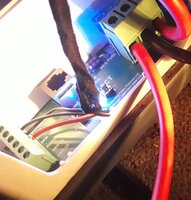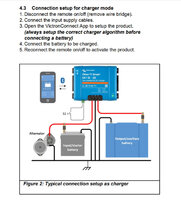My Sterling BB1230 appears to be 'buggered'. I had been thinking of replacing it with a Victron unit at some point so that's now moved to the top of the list.
The unit has previously worked and indications suggest the wiring is okay, so I'm wondering if I can lift out the Sterling and do a straight swap with the Victron Orion Smart Tr 12/12-30A .
Current BB1230 wiring :

Victron manual page - DC charger wiring :

1. Is this a straight swap for someone who knows a bit but not enough about vehicle electrics?
2. The remote on/off confuses me, not sure what this is for, I'd have thought it could be switched off via the app. Anything to concern myself about?
3. I think it's the non-isolated version I require?
4. Need I concern myself with the engine-on detection or is it set up easily enough?
5. Any snags using existing cables to leisure and starter batteries?
6. Location, the unit will take the place of the Sterling under the drivers seat alongside the diesel heater, concerns about clearance?
I've a Euro 6 van converted to campervan with 160w solar through Victron MPPT and also have a Victron Smart Charger for hookup. Battery is a Lion Calcium type 100Ah which at some point I'd like to swap out for an AGM 110ah, or in a perfect world Lithium.
The unit has previously worked and indications suggest the wiring is okay, so I'm wondering if I can lift out the Sterling and do a straight swap with the Victron Orion Smart Tr 12/12-30A .
Current BB1230 wiring :

Victron manual page - DC charger wiring :

1. Is this a straight swap for someone who knows a bit but not enough about vehicle electrics?
2. The remote on/off confuses me, not sure what this is for, I'd have thought it could be switched off via the app. Anything to concern myself about?
3. I think it's the non-isolated version I require?
4. Need I concern myself with the engine-on detection or is it set up easily enough?
5. Any snags using existing cables to leisure and starter batteries?
6. Location, the unit will take the place of the Sterling under the drivers seat alongside the diesel heater, concerns about clearance?
I've a Euro 6 van converted to campervan with 160w solar through Victron MPPT and also have a Victron Smart Charger for hookup. Battery is a Lion Calcium type 100Ah which at some point I'd like to swap out for an AGM 110ah, or in a perfect world Lithium.


